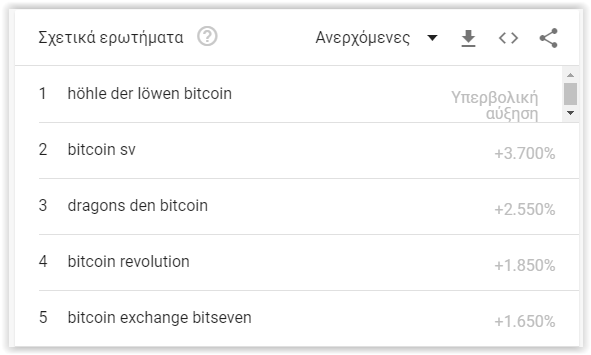Η μεγαλύτερη τράπεζα της Αμερικής συνεχίζει να “σκουπίζει” την αγορά εργασίας, προσλαμβάνοντας ή έστω αναζητώντας μανιωδώς ειδικούς στο blockchain, με ρυθμούς που ξεπερνούν κάθε άλλη εταιρεία του χρηματοπιστωτικού κλάδου.
Σύμφωνα με στοιχεία του ιστότοπου αγγελιών και αναζήτησης εργασίας Indeed.com, η JPMorgan Chase ήταν η μόνη εταιρεία του χρηματοπιστωτικού τομέα μεταξύ των 10 εργοδοτών στις αγγελίες των οποίων εμφανίζονται πιο συχνά οι λέξεις blockchain, cryptocurrency (κρυπτονομίσματα) ή bitcoin τον τελευταίο χρόνο.
Τον Φεβρουάριο του 2019, η JPMorgan Chase παρουσίασε το JPM Coin, ένα σχέδιό της για χρήση του blockchain προς απλοποίηση των πληρωμών μεταξύ πελατών της, ενώ νωρίτερα είχε δημιουργήσει μία εκδοχή blockchain του ethereum, ονόματι Quorum, σχεδιασμένη να επιτρέπει στις επιχειρήσεις να κεφαλαιοποιούν τα οφέλη από τη χρήση κοινού μητρώου, ανάλογου με το blockchain του bitcoin, με μεγαλύτερη όμως έλεγχο της ιδιωτικότητας και σε ταχύτερη μορφή.
Οι μόνες εταιρείες που έχουν αναρτήσει περισσότερες αγγελίες αναζήτησης εργαζομένων οι οποίοι ειδικεύονται στο blockchain ήταν οι τεχνολογικές IBM και Cisco, καθώς και οι συμβουλευτικές Accenture, EY, KPMG και Deloitte, με την τελευταία να κατέχει την πρώτη θέση. Τη δεκάδα ολοκληρώνει η Microsoft, η εξειδικευμένη στο ethereum ConsenSys και η όχι ιδιαίτερα γνωστή Conduent, η οποία “αποσχίστηκε” από την Xerox το 2017 και χτίζει πλατφόρμες για μεγάλες επιχειρήσεις και κυβερνήσεις.
“Είναι αξιοσημείωτο ότι εταιρείες χρηματιστικών και τραπεζικών δραστηριοτήτων δεν προσλαμβάνουν αρκετά για μια τεχνολογία η οποία έχει στόχο να αντικαταστήσει το χρήμα”, τονίζει ο οικονομικός αναλυτής του Indeed.com, Andrew Flowers, ο οποίος παρακολουθεί τα σχετικά στατιστικά στοιχεία εδώ και περισσότερο από έναν χρόνο. Διπλά αξιοσημείωτο, προσθέτει, είναι το γεγονός ότι πλέον οι αγγελίες για προσλήψεις είναι περισσότερες από τις σχετικές αναζητήσεις από την πλευρά όσων ψάχνουν δουλειά.
Από τον Φεβρουάριο του 2018 έως τον Φεβρουάριο του 2019, το ποσοστό των σχετικών με το blockchain αναζητήσεων για εργασία στον ιστότοπο έχει μειωθεί κατά 67%, με τον Flowers να συνδέει την συγκεκριμένη πτώση με την κατάρρευση της τιμής του bitcoin και άλλων κρυπτονομισμάτων. “Τα ενδιαφέροντα του αναζητούντα εργασία είναι τόσο ευμετάβλητα, όσο και η τιμή του bitcoin”, προσθέτει.
Μολονότι η έρευνα δεν απασχολείται με το ερώτημα του γιατί οι αγγελίες για εργασία στον συγκεκριμένο τομέα αυξάνονται παρά την πτώση της τιμής των βασικών κρυπτονομισμάτων, μία από τις πιθανές εξηγήσεις είναι η πρόσφατη αύξηση των μεγάλων εταιρειών που εξερευνούν τις μη σχετικές με τα κρυπτονομίσματα δυνατότητες του blockchain. Μολονότι το αποκεντρωμένο, διαμοιρασμένο, κοινό μητρώο του blockchain που υποστηρίζει το bitcoin υποσχόταν στους ανθρώπους ότι θα μπορούν να μεταβιβάζουν αξίες χωρίς μεσάζοντες όπως οι τράπεζες, μεγάλες εταιρείες εξερευνούν πλέον το πώς κάτι τέτοιο μπορεί να γίνει, επί τη βάσει της ίδιας τεχνολογίας για τις δικές τους μεταβιβάσεις.
Για να δώσει μία ευρύτερη οπτική στην συγκεκριμένη τάση, η έρευνα του Indeed.com αναδεικνύει μια αύξηση 4,086% στις αγγελίες για εργασία από το 2016 μέχρι σήμερα, ενώ η αντίστοιχη αύξηση στην αναζήτηση θέσεων εργασίας αγγίζει το 553% την ίδια περίοδο. Για να καλύψουν αυτό το χάσμα, παραδοσιακοί θεσμοί όπως το πανεπιστήμιο του Berkley και ειδικά προγράμματα όπως το Blockchain Education Network βρίσκονται σε εξέλιξη για ειδίκευση νέων ταλέντων στον κόσμο του blockchain.
Η ζήτηση για τις συγκεκριμένες θέσεις εργασίας εντοπίζεται κυρίως σε περιοχές όπως η Silicon Valley και το Σαν Φρανσίσκο, ενώ ακολουθούν η Νέα Υόρκη, το Newark, το New Jersey και το Jersey City, που ισοψηφούν στην τρίτη θέση. Το γεωγραφικό top 10 κλείνουν το Austin, πρωτεύουσα του Texas, το Seattle, το, Denver, το Colorado, η πρωτεύουσα των ΗΠΑ Ουάσινγκτον, η Βοστόνη, η Μασαχουσέτη και το Λος Άντζελες.
Πηγή: https://www.capital.gr/forbes/


 Η συνολική χρηματιστηριακή αξία όλων των κρυπτονομισμάτων αυξήθηκε σημαντικά κατά τη διάρκεια της αιφνίδιας αύξησης της αγοράς σήμερα. Ενώ το χθεσινό υψηλότερο σημείο ήταν στα 146 δισεκατομμύρια δολάρια, η σημερινή κορυφή ήταν στα 163 δισεκατομμύρια δολάρια.
Η συνολική χρηματιστηριακή αξία όλων των κρυπτονομισμάτων αυξήθηκε σημαντικά κατά τη διάρκεια της αιφνίδιας αύξησης της αγοράς σήμερα. Ενώ το χθεσινό υψηλότερο σημείο ήταν στα 146 δισεκατομμύρια δολάρια, η σημερινή κορυφή ήταν στα 163 δισεκατομμύρια δολάρια.












